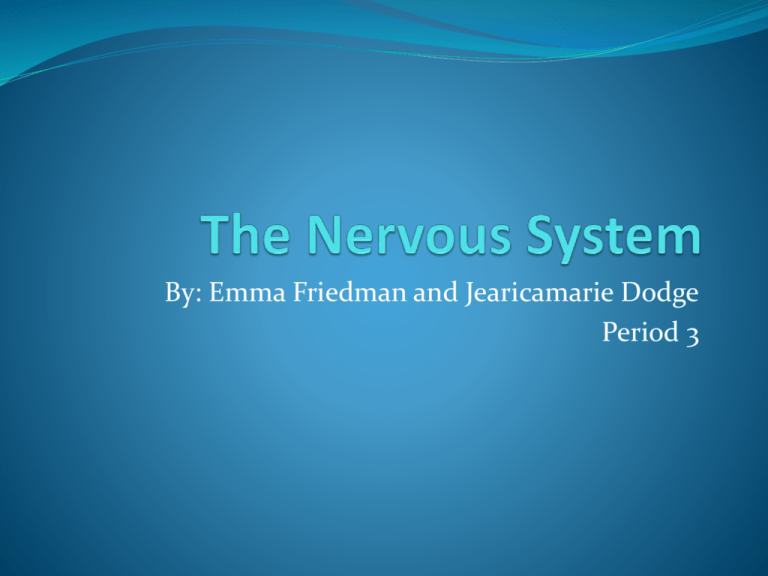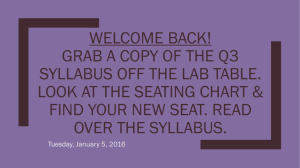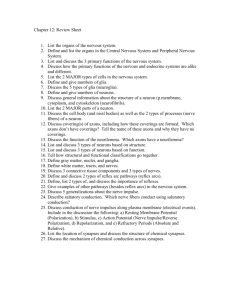The Nervous System
advertisement

By: Emma Friedman and Jearicamarie Dodge Period 3 Function of the System The nervous system allows us to sense our surroundings, bringing inside and outside information to our brain and spinal cord to interpret. The three main functions of the nervous system are the: • Sensory function • Integrative function • Motor function The Neuron The main parts of a neuron are the: •Cell body- The nucleus (and the nucleolus) lie within the cell body, along with chromatophilic substance. There are also various organelles in the body such as mitochondria. •Dendrites- Dendrites are the main receptors of the neuron and communicate with other neurons’ axons. •Tubular- The areas of the tubular not covered by Schwann cells are referred to as Nodes of Raniver. •Axon- Axons communicate with other neurons and extend from the axonal hillcock. oUnmyelinated axons appear as gray matter, myelinated as white matter. There are extensions at the end of the axon that do the communicating. The Synapse When two neurons communicate, the junction is called a synapse. •The two neurons are separated by the synaptic cleft •The neuron carrying the impulse is the presynaptic neuron, and the receiver the postsynaptic neuron. Synapses and Neurotransmitters Neurotransmitters are the biochemicals that carry out synaptic transmission. •The synaptic vesicles that lie within the synaptic knobs on the ends of axons release the neurotransmitters, which then travel across the synaptic cleft. The Central Nervous System The central nervous system includes the brain and the spinal cord, which connects to the brainstem. The Brain Major Aspects of the Brain Cerebrum Ventricles and Cerebrospinal Fluid Dicencephalon Brainstem Cerebellum The Cerebrum The Cerebrum The lobes of the cerebrum: Frontal lobe Parietal lobe Temporal lobe Occipital lobe Insula Function of the Cerebrum The cerebrum performs many high-level functions. • The motor areas are in the frontal lobes, and its tissue consists of pyramidal cells, which send impulses to skeletal muscle fibers. • Sensory areas are in various lobes and interpret information from sensory receptors, thus producing sensations or feelings. • Association areas are also in various lobes, and connect with other brain structures. They deal with things like memory, reasoning, and judgment. Ventricles and Cerebrospinal Fluid Diencephalon The thalamus and hypothalamus lie within the diencephalon. The thalamus receives and sends to the cortex sensory impulses except for smell. The hypothalamus regulates many visceral activities, which maintains homeostasis. It also links the endocrine to the nervous system. The other structures in the diencephalon make up the limbic system, which modifies a person’s behavior and emotions based on their outside situation. Brainstem Brainstem Parts and Functions The brainstem is composed of the midbrain, pons, medulla • • • • oblongata, and reticular formation. Midbrain: Contains bundles of myelinated axons that join the brainstem to the spinal cord and the brain. Pons: A small sphere that transmits impulses from the cerebrum to cerebellum Medulla Oblongata: All nerve fibers from the brain to spinal cord run through it, as it is part of the fourth ventricle. Reticular formation: Is a network of nerve fibers scattered throughout the brainstem, which arouses the otherwise “sleeping” cortex. Cerebellum The cerebellum communicates with the rest of the CNS by way of cerebellar peduncles. It’s main function is to integrate sensory information in relation to body position and movement of skeletal muscles. Peripheral Nervous System The peripheral nervous system is divided into the autonomic and somatic nervous systems. The system includes the cranial and spinal nerves. The CNS consists of the brain and spinal cord, and the PNS of the body’s nerves. The Autonomic Nervous System The autonomic nervous system is the part of the PNS that functions independently. It’s function is to regulate the actions of muscles and glands, as well as heart rate and blood pressure, breathing rate, body temperature, and maintaining homeostasis in general. Sympathetic and Parasympathetic Divisions Sympathetic Level: • Its fibers originate in the gray matter of the spinal cord. The axons exit through ventral roots of spinal nerves • Once they have left the spinal nerves, the fibers form paravertebral ganglia. Parasympathetic Level: • Its fibers originate in the brainstem. • They proceed outward in cranial/sacral nerves in order to reach ganglia. • The postganglionic fibers extend to certain muscles in viscera. Somatic Senses Touch and pressure senses: Their receptors are free nerve endings in epithelial tissue, Meissner’s corpuscles that sense extremely light touch, and Pacinian corpuscles, which respond to deep pressure. Temperature senses: There are warm and cold receptors of free nerve endings. Sense of pain: Free nerve endings dispersed throughout the body (excluding the brain) sense pain. According to referred pain, visceral pain often feels as though it is occurring in a different area of the body. Smell and Taste Similar Both sensations must adapt very quickly to the environment For both senses, substances must dissolve in liquid to cause a stimulation Just as the nose has hairs, taste hairs extend from each taste pore, and both types are major receptors Different Despite their many similarities, smell impulses are eventually sent to the temporal lobes, and taste impulses to the parietal lobe. Diseases and Disorders Parkinson's: The disease often occurs after age 50, when the nerve cells that make dopamine slowly die. Dopamine controls muscle movement, and the person therefore can lose simple abilities like blinking and swallowing. Alzheimer's: It’s a form of dementia that progressively becomes worse. It often first appears as forgetfulness, but can lead to loss of cognitive skills. Multiple Sclerosis: It is caused by damage to the myelin sheath, which exposes nerve cells that can slow down or stop. There are various symptoms, some of which are loss of balance, tremors, and loss of coordination. Sources http://www.ncbi.nlm.nih.gov/pubmedhealth/PMH00 01762/ http://www.ncbi.nlm.nih.gov/pubmedhealth/PMH00 01767/ http://www.ncbi.nlm.nih.gov/pubmedhealth/PMH00 01747/ All pictures were taken from Hole’s Essentials of Human Anatomy and Physiology; McGraw-Hill Higher Education







